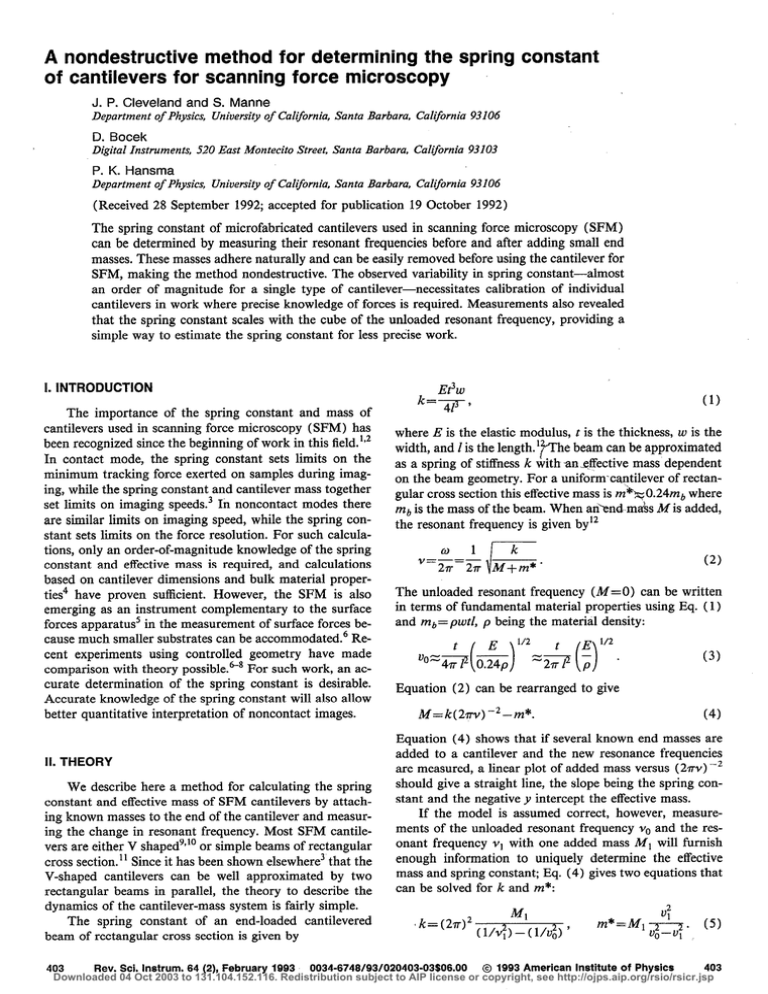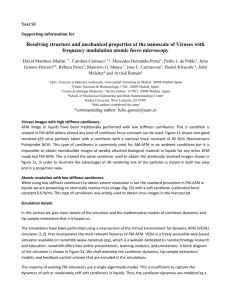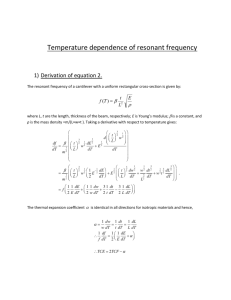A nondestructive method for determining the spring constant of
advertisement

A nondestructive
method for determining the spring constant
of cantilevers for scanning force microscopy
J. P. Cleveland
and S. Manne
Department of Physics, University of California, Santa Barbara, California 93106
D. Bocek
Digital Instruments, 520 East Montecito Street, Santa Barbara, California 93103
P. K. Hansma
Department of Physics, University of California. Santa Barbara, California 93106
(Received 28 September 1992; accepted for publication
19 October 1992)
The spring constant of microfabricated cantilevers used in scanning force microscopy (SFM)
can be determined by measuring their resonant frequencies before and after adding small end
masses. These masses adhere naturally and can be easily removed before using the cantilever for
SFM, making the method nondestructive. The observed variability in spring constant-almost
an order of magnitude for a single type of cantilever-necessitates
calibration of individual
cantilevers in work where precise knowledge of forces is required. Measurements also revealed
that the spring constant scales with the cube of the unloaded resonant frequency, providing a
simple way to estimate the spring constant for less precise work.
I. INTRODUCTION
The importance of the spring constant and mass of
cantilevers used in scanning force microscopy (SFM) has
been recognized since the beginning of work in this field.lP2
In contact mode, the spring constant sets limits on the
minimum tracking force exerted on samples during imaging, while the spring constant and cantilever mass together
set limits on imaging speeds3 In noncontact modes there
are similar limits on imaging speed, while the spring constant sets limits on the force resolution. For such calculations, only an order-of-magnitude knowledge of the spring
constant and effective mass is required, and calculations
based on cantilever dimensions and bulk material properties4 have proven sufficient. However, the SFM is also
emerging as an instrument complementary to the surface
forces apparatus5 in the measurement of surface forces because much smaller substrates can be accommodated.6 Recent experiments using controlled geometry have made
comparison with theory possible.&* For such work, an accurate determination of the spring constant is desirable.
Accurate knowledge of the spring constant will also allow
better quantitative interpretation of noncontact images.
II. THEORY
We describe here a method for calculating the spring
constant and effective mass of SFM cantilevers by attaching known masses to the end of the cantilever and measuring the change in resonant frequency. Most SFM cantilevers are either V shaped”” or simple beams of rectangular
cross section.” Since it has been shown elsewhere3 that the
V-shaped cantilevers can be well approximated by two
rectangular beams in parallel, the theory to describe the
dynamics of the cantilever-mass system is fairly simple.
The spring constant of an end-loaded cantilevered
beam of rectangular cross section is given by
403
Rev. Sci. Instrum. 64 (2), February 1993
E8w
“=4p,
(1)
where E is the elastic modulus, t is the thickness, w is the
width, and I is the length.‘{ZThe beam can be approximated
as a spring of stiffness k with aneffective mass dependent
on the beam geometry. For a uniform-cantilever of rectangular cross section this effective mass is m”x0.24mb
where
mb is the mass of the beam. When an&d-m&
M is added,
the resonant frequency is given byI
(2)
The unloaded resonant frequency (M=O) can be written
in terms of fundamental material properties using Eq. ( 1)
and mb=pwtl, p being the material density:
~o=J&&J’ii=&
(3)
g2.
Equation (2) can be rearranged to give
M=k(2w)-2-m*.
(4)
Equation (4) shows that if several known end masses are
added to a cantilever and the new resonance frequencies
are measured, a linear plot of added mass versus (27rv) m-2
should give a straight line, the slope being the spring constant and the negative y intercept the effective mass.
If the model is assumed correct, however, measurements of the unloaded resonant frequency v. and the resonant frequency v, with one added mass M, will furnish
enough information to uniquely determine the effective
mass and spring constant; Eq. (4) gives two equations that
can be solved for k and m*:
Ml
,k=(2a)2
0034-6746/93/020403-03$06.00
(l/+(l/v~>
7
rn*=M1-2.
4
@ 1993 American Institute of Physics
(5)
1
403
Downloaded 04 Oct 2003 to 131.104.152.116. Redistribution subject to AIP license or copyright, see http://ojps.aip.org/rsio/rsicr.jsp
60
0
5
IO
15
Frequency
20
25
30
(kHz)
FIG. 1. Resonances curves of the same cantilever with and without an
added end mass. No external driving force was applied since thermal
excitation provided large enough oscillations (of order 1 nm). The lower
curve is for the cantilever with no end mass and shows a peak at 22.4 kHz,
and the upper curve is of the same cantilever with a 44 ng end mass. The
resonance frequency has shifted to 9.4 kHz and the Q of the oscillation
has increased since the mass of the system had increased but the frictional
damping (proportional to the cross-sectional area) has not. The two
curves are properly scaled, but the vertical offset is arbitrary.
III. MATERIALS
AND METHODS
We made our measurements on 200~pm-long, 36+mwide V-shaped Si3N4 cantilevers,’ though the method
should be applicable to all SFM cantilevers. We used atomized tungsten spheresI for test masses. The tungsten
powder was polydispersed with a mean particle diameter of
20 pm and a standard deviation of 15 ,um, giving us a wide
size distribution from which to choose test masses. Light
microscopy showed the particles to be spherical. Particle
mass was calculated by measuring the sphere radius and
using the bulk density of tungsten, 19.3 g/cm3.
All measurements shown here were made in a homebuilt stand-alone atomic force microscope (AFM) using
commercial electronics,’ but could easily be done in any
working SFM. The controller was used simply to supply
power to the laser didde and the preamp electronics. The
deflection of the cantilever was detected using optical-beam
deflection.14 The split-segment photodiode signal was intercepted after the preamp and fed into a spectrum analyzer.
The tungsten spheres were placed near the end of the
cantilever, on the same side as the integrated tip, using a
glass micropipette on a three-way micropositioner
under
a 35 X stereoscope.‘6 We found the adhesion present
(probably capillary) in the tungsten-glass and tungstenSi3N4 interactions (in air of 40%-70% humidity) strong
enough to move and then secure the spheres to the cantilever, making the method nondestructive. Figure 1 shows
the resonance curve of a cantilever with and without an
added end mass.
FIG. 2. A plot of added mass vs (25-v) -* for a single cantilever. A simple
linear regression of the data gives a spring constant (slope) of 0.031
*O.OOl N/m and an effective mass (negative y intercept) of 6.2 ng with
a correlation coefficient of 0.997.
12.4 kHz. Figure 2 shows the expected linear relationship
between added mass and (2qv) s2, verifying Eq. (4). The
error quoted is the standard error based on the data set and
does not include systematic error; two obvious sources are
the measurement of the tungsten sphere diameters and the
fact that the spheres were only positioned within 20 pm of
the integrated tip (where forces will be applied during imaging). Both these errors could be minimized by the use of
precalibrated masses (e.g., monodisperse spheres) and
more careful positioning. Of more relevance is the spread
in the spring constant when calculated on a point by point
basis using Eq. (5). These values ranged from 0.023 to
0.031 N/m. The values for the two heaviest masses were
0.031 and 0.029 N/m, indicating that much of the error
was probably in measuring the diameter of the smaller
spheres.
Once the model had been verified, we measured the
spring constant of five more cantilevers of the same type
but from different wafers by adding only a single mass. We
saw a spread in resonant frequency from 12.3 to 22.1 kHz
and corresponding spring constants from 0.028 to 0.18
N/m, with larger spring constants always corresponding to
higher resonant frequency.
Because of the large variability in the spring constants,
cantilevers will have to be calibrated on an individual basis
when used for precision force measurements. This variability is most likely caused by variations in thickness of the
cantilevers.” Variability in the length and width of the
cantilever is quite small since typical lateral resolution in
photolithography is submicrometer. On the other hand,
other workers have observed thickness variations from 0.4
to 0.7 pm.3
If it is assumed that the cantilevers are identical except
for variations in thickness, it can be shown using Eqs. ( 1)
and (3) that the spring constant is proportional to the cube
of the unloaded resonant frequency, specifically
k=2r
313w BEG.
(6)
Five measurements using spheres varying in diameter
from 6.5 pm (mass 2.8 ng) to 16.3 pm (43.8 ng) were
made on a single cantilever whose unloaded frequency was
Figure 3 shows that our data roughly obeyed this scaling
law, with a proportionality constant close to that expected
theoretically. T&s provides a means of estimating the
spring constant by simply measuring the unloaded resonance frequency. For example, the method predicted a
404
Scanning force microscopy
IV. RESULTS
AND DISCUSSION
Rev. Sci. Instrum., Vol. 64, No. 2, February 1993
Downloaded 04 Oct 2003 to 131.104.152.116. Redistribution subject to AIP license or copyright, see http://ojps.aip.org/rsio/rsicr.jsp
404
spring constants, 0. IO+O.Ol N/m, while the fourth had a
resonance frequency of 54 kHz and a measured spring constant of 0.36 N/m.
k (N/m)
ACKNOWLEDGMENTS
W e thank N. Kopatz for the tungsten spheres, and W .
A. Ducker and J. H. Hoh for useful discussion. This work
was supported by the Office of Naval Research (P.K.H.),
the National Science Foundation (P.K.H.), and by fellowships from Digital Instruments (J.P.C.) and AT&T
(S.M.).
FIG. 3. A plot of measured spring constant vs the cube of unloaded
resonance frequency for six cantilevers. The dashed line is a simple linear
regression to the data and the solid line is the theoretical line from Eq.
(6). W e used a two-beam approximation with Z=200 pm, w=36 pm,
and the material properties of SiaN, (see Ref. 18).
spring constant of 0.029 N/m for the cantilever of Fig. 2
whose measured spring constant was 0.03 1 f 0.001 N/m.
In conclusion, we have verified that a simple model
describes variation in resonance frequency as a function of
added end mass for a common type of SFM cantilever,
thus providing a nondestructive means of determining the
spring constant and effective mass. Cantilevers produced
using current manufacturing methods have large enough
variability in spring constant that calibration should be
done on an individual basis for precision work. For less
precise work, measurement of unloaded resonance frequencies gives an estimate of the spring constant via Eq. (6).
An interesting application of the mechanical system
not yet discussed is its use as a nanogram scale. Once the
spring constant and effective mass of a cantilever are calculated using the technique discussed, an unknown end
mass can be determined using Eq. (4). The smallest end
mass used above was 2.3 ng. W e estimate our mass resolution to be 0.5 ng.
Note added in prooj W e also made measurements on
four 120~,um-long, 22-pm-wide V-shaped silicon nitride
cantilevers,’ three from different locations in a single wafer
and one from a second wafer. The three had similar resonance frequencies, 37A 1 kHz, and similar measured
‘G. Binnig, C. F. Quate, and Ch. Gerber, Phys. Rev. Lett. 56, 930
(1986).
*G. Binnig, Ch. Gerber, E. Stoll, T. R. Albrecht, and C. F. Quate,
Europhys. Lett. 3, 1281 (1987).
3H.-J. Butt, P. Siedle, K. Seifert, K. Fendler, T. Seeger, E. Bamberg, A.
L. Weisenhorn, K. Goldie, and A. Engel, Microsc. (to be published).
4T. R. Albrecht, S. Akamine, T. E. Carver, and C. F. Quate, J. Vat. Sci.
Technol. A 8, 3386 (1990).
‘5. N. Israelachvilli and G. E. Adams, J. Chem. Sot. Faraday Trans. I,
975 (1978).
6W. A. Ducker and T. J. Senden, Langmuir 8, 1831 (1992).
7W. A. Ducker, T. J. Senden, and R. M. Pashley, Nature 353, 239
(1991).
sY. Q. Li, N. J. Tao, A. A. Garcia, and S. M. Lindsay (unpublished).
‘Digital Instruments, Santa Barbara, CA.
‘“Microlevers, Park Scientific Instruments, Sunnyvale, CA.
” Nanoprobe, Dr. U. Wolter, Institut fiir Technologientwicklung, D-6330
Wetzlar-Blankenfeld, Germany.
‘sW. F. Stokey, Shock and Vibration Handbook (McGraw-Hill,
New
York, 1989), pp. 7.1-7.44.
I3 GTE Sylvania, Towanda, PA.
14G. Meyer and N. M. Amer, Appl. Phys. Lett. 53, 1045 (1988).
i5Liie Tool Co., Allentown, PA.
16The micropipettes were formed by pulling 1 m m glass tubules over a
small bunsen burner flame. Using this method, micropipettes with
micrometer-sized diameters could be fabricated. W e found that pipettes
that necked down to the smallest diameter over a short distance worked
well since they resisted bending.
17Variations in the elastic modulus or density are also a possibility. Since
the Si3N4 cantilevers are made using chemical-vapor deposition, the
exact stoichiometry is not known. The range can be as high as
Si3-iSN4[A. L. Weisenhorn, P. Maivald, H. J. Butt, and P. K. Hansma,
Phys. Rev. B 45, 11 226 (1992)]. However, for the measured values of
spring constant and resonant frequency to remain consistent with Eqs.
( 1) and (3), the elastic modulus would have to vary by a factor of 6 and
the denstiy by 50%.
I8 Sarid, Scanning Force Microscopy With Applications to Electric, Magnetic, and Atomic Forces (Oxford University, London, 1991).
Scanning force microscopy
405
Rev. Sci. Instrum., Voi; 64, No. 2, February 1993
405
Downloaded 04 Oct 2003 to 131.104.152.116. Redistribution subject to AIP license or copyright, see http://ojps.aip.org/rsio/rsicr.jsp



